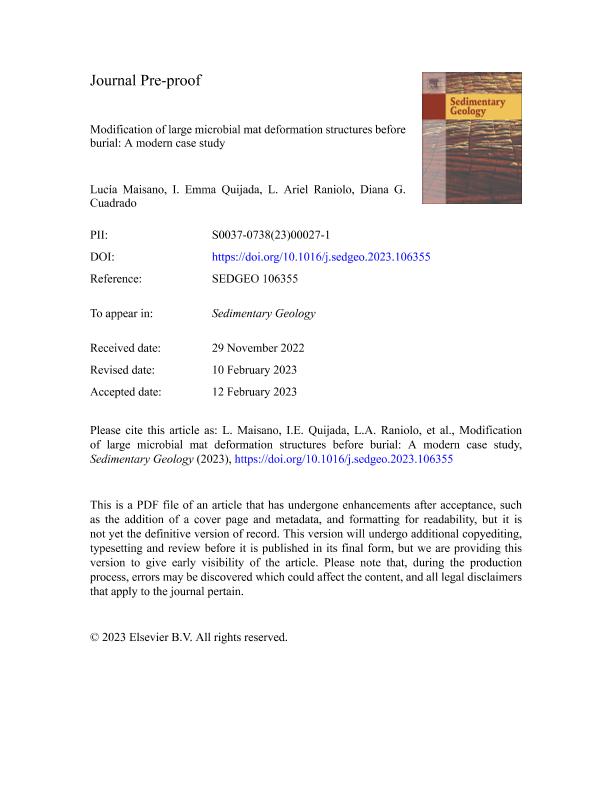Mostrar el registro sencillo del ítem
dc.contributor.author
Maisano, Lucia

dc.contributor.author
Quijada, I. Emma
dc.contributor.author
Raniolo, Luis Ariel

dc.contributor.author
Cuadrado, Diana Graciela

dc.date.available
2024-04-17T13:35:38Z
dc.date.issued
2023-02
dc.identifier.citation
Maisano, Lucia; Quijada, I. Emma; Raniolo, Luis Ariel; Cuadrado, Diana Graciela; Modification of large microbial mat deformation structures before burial: A modern case study; Elsevier Science; Sedimentary Geology; 447; 2-2023; 1-36
dc.identifier.issn
0037-0738
dc.identifier.uri
http://hdl.handle.net/11336/233285
dc.description.abstract
The presence of microorganisms gives remarkable plasticity and flexibility to wet sediments. Under these circumstances, a coherent microbial mat is developed, which is loosely attached to the underlying sediment layer. These thick microbial mats are capable of being lifted from the underlying sediments in response to high-energy events, such as currents and waves forming several types of synsedimentary microbial mat deformation structures. This study analyses excellent examples of these structures developed in Paso Seco (Argentina), a modern coastal flat colonized by microbial mats frequently inundated during storms, and the modifications that affect them before burial. To achieve this, the hydrodynamic conditions in the coastal flat over time were interpreted from water level records obtained with HOBO loggers. Field photographs were obtained to document the microbial structures (such as flipped-overs, tear mats, roll-ups, mat chips, and folds) covering the area after a high-energy event and over the course of the following two years. Specifically, emphasise was put in roll-up structures because of their large size. Sediment samples were extracted to make thin sections for petrography analysis. Once the microbial structures are formed, they show gradual changes caused by the hydrodynamic conditions that control the sedimentary environment, and on several occasions, these changes are preserved in the sedimentary profile. Our observations and measurement of modern sedimentary structures and the in-situ documentation of their evolution may be helpful for the identification and interpretation of analogous sedimentary structures in the fossil record, which could have undergone similar modifications prior to their burial.
dc.format
application/pdf
dc.language.iso
eng
dc.publisher
Elsevier Science

dc.rights
info:eu-repo/semantics/openAccess
dc.rights.uri
https://creativecommons.org/licenses/by-nc-sa/2.5/ar/
dc.subject
Microbial mats
dc.subject
Deformation structures
dc.subject
Roll-up structures
dc.subject
erosion
dc.subject.classification
Otras Ciencias Naturales y Exactas

dc.subject.classification
Otras Ciencias Naturales y Exactas

dc.subject.classification
CIENCIAS NATURALES Y EXACTAS

dc.title
Modification of large microbial mat deformation structures before burial: A modern case study
dc.type
info:eu-repo/semantics/article
dc.type
info:ar-repo/semantics/artículo
dc.type
info:eu-repo/semantics/publishedVersion
dc.date.updated
2024-04-17T13:05:43Z
dc.journal.volume
447
dc.journal.pagination
1-36
dc.journal.pais
Países Bajos

dc.journal.ciudad
Amsterdam
dc.description.fil
Fil: Maisano, Lucia. Consejo Nacional de Investigaciones Científicas y Técnicas. Centro Científico Tecnológico Conicet - Bahía Blanca. Instituto Argentino de Oceanografía. Universidad Nacional del Sur. Instituto Argentino de Oceanografía; Argentina. Universidad Nacional del Sur. Departamento de Geología; Argentina
dc.description.fil
Fil: Quijada, I. Emma. Universidad de Oviedo; España
dc.description.fil
Fil: Raniolo, Luis Ariel. Consejo Nacional de Investigaciones Científicas y Técnicas. Centro Científico Tecnológico Conicet - Bahía Blanca. Instituto Argentino de Oceanografía. Universidad Nacional del Sur. Instituto Argentino de Oceanografía; Argentina
dc.description.fil
Fil: Cuadrado, Diana Graciela. Universidad Nacional del Sur. Departamento de Geología; Argentina. Consejo Nacional de Investigaciones Científicas y Técnicas. Centro Científico Tecnológico Conicet - Bahía Blanca. Instituto Argentino de Oceanografía. Universidad Nacional del Sur. Instituto Argentino de Oceanografía; Argentina
dc.journal.title
Sedimentary Geology

dc.relation.alternativeid
info:eu-repo/semantics/altIdentifier/url/https://linkinghub.elsevier.com/retrieve/pii/S0037073823000271
dc.relation.alternativeid
info:eu-repo/semantics/altIdentifier/doi/http://dx.doi.org/10.1016/j.sedgeo.2023.106355
Archivos asociados
